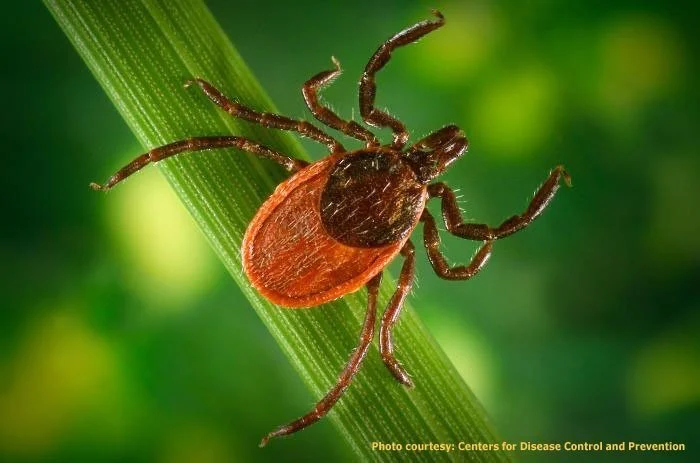Tick Update 2025
Growing risk of Lyme Disease in Ivry-sur-le-lac and Lac manitou region
Here’s what you need to know.
Lyme disease is on the rise across the province and right here in the Lac Manitou region. Public health authorities are warning that significant populations of black-legged deer ticks have taken up residence in our local fields and woods, our yards and gardens. Some of them carry borrelia burgdorferi — the pathogen that causes Lyme disease.
Lyme disease can cause serious symptoms including rash, fever, joint pain, and neurological symptoms if untreated. But it is very treatable, especially when caught early. Better yet, there are simple steps you can take to avoid tick bites altogether. Now that ticks have joined the local habitat, here’s what you need to know.
How serious is the tick problem?
In 2009, across Canada, 144 reported cases of Lyme disease. In 2024, there were more than 5000 cases. That’s a 3,537.5% increase over 15 years.
Ticks weren’t common in Canada until recently. Warmer, more moderate weather has fueled population migration and expansion. Most of Quebec now offers a suitable climate for ticks to survive and reproduce.
Over the last five years, tick bites have been increasingly common but have led to fewer than 1000 confirmed diagnoses of Lyme disease per year across the whole province. In 2023, there were 652 confirmed lyme diagnoses across the province with a total of 8 in the Laurentides. Of those eight, only four were confirmed to have been contracted in the Laurentians.
The Laurentides public health authority is actively warning residents that black-legged ticks are firmly established and infected in our area and many of the surrounding municipalities. There is lots of information to be found on their website.
What do ticks look like?
Adult black-legged deer ticks — the ones we have to worry about — are tiny, about the size of a sesame seed. In their youth (as nymphs) they look like poppy seeds. When they feed, they fill up with blood and get fat and round.
Adult black-legged deer tick
Where are they found?
Ticks live where it is wet and shady. They like fields and forests, wherever there are grasses, bushy foliage and leaf litter.
How to avoid getting bitten
Do not leave skin exposed. Wear long pants and sleeves. Tuck your pant legs into your socks to protect your ankles and legs.
Apply insect repellents with DEET or icaridin or wear clothing treated with Permethrin
Protect your pets with tick collars, sprays or oral medications.
Shower within 2 hours of coming indoors and do a full body tick check.
what about repellents?
Yes. DEET (≥20%) and icaridin (≥20%) are effective against ticks. Apply to exposed skin and outer clothing.
Check yourself for bites.
After outdoor activity, inspect your body thoroughly—especially under arms, behind knees, around the waist, in the groin, and on the scalp. You may need someone else’s help to check your back. Make sure to check children and pets for ticks too.
Identifying tick bites
It doesn’t hurt when a tick attaches so they often go unnoticed. The first sign of Lyme might be a red rash that develops within 3-30 days of being bitten. The growing rash may or may not look like a bullseye. But not all cases result in a rash. A bite can leave no visible sign at all.
if you find a tick
Use tweezers to grasp the tick as close to the skin as possible.
Remove the tick with tweezers by pulling it straight out without twisting.
Do not twist, instead pull the tick straight out with steady firm force.
Clean the site with soap and water and apply antiseptic.
Save the tick in a container for possible identification.
Time is of the essence when dealing with ticks. It is important to get them off of your skin within 24 hours. Once bitten, consult a physician or pharmacist immediately. Within 72 hours of being bitten a single dose of doxycycline may prevent Lyme disease.
What to do if your pet gets bitten
Remove the tick using tweezers. Clean the site and save the tick for identification purposes. Consult your vet.
Do all ticks carry lyme disease?
Only black-legged ticks (Ixodes scapularis) transmit Lyme disease, and not all black-legged ticks are infected. Risk increases in known high-risk areas. Other varieties of ticks may carry other pathogens.
More information
Municipalities at Elevated Risk for Lyme Disease (Government of Quebec site)
Lyme and other Tick Transmitted Diseases (Quebec Government site)







